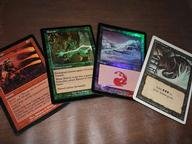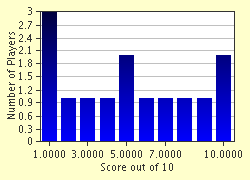Quiz Answer Key and Fun Facts
1. A strong component of "Magic: The Gathering" are the colours of magic. There are five different colours, and each one has its own themes, strengths, and weaknesses. Which of the five colours of "Magic: The Gathering" is associated with nature and strength?
2. Almost every "Magic: The Gathering" card has a colour. Some have more than one, and some have none at all, but most have just one. Which of the five colours of "Magic: The Gathering" is associated with order, discipline, and unity?
3. Which of the five colours of "Magic: The Gathering" is associated with ambition and personal power, whatever the cost?
4. Which of the five colours of "Magic: The Gathering" is associated with technology, manipulation, and subterfuge?
5. Which of the five colours of "Magic: The Gathering" is associated with speed, recklessness, and chaos?
6. Players are allowed to construct their decks using whichever cards they want to. Sometimes this would mean using only a single colour in a deck (mono-coloured), but often time players would make use of two or more colours to be more versatile. In 2005, Wizards of the Coast created ten guilds, one for each of the two-colour combinations. Where do these guilds hail from?
7. The five colours of "Magic: The Gathering" are organized in a circle (the colour pie). For any colour, the two colours next to it are said to be its "ally colours" while the colours opposite are called "enemy colours". In 2008, Wizards of the Coast released a set that focused on the "shard" three-colour combinations (a colour working with both its allies). What is the name of the plane (and associated block) that these shards are named after?
8. Another set of possible three-colour combinations are the "wedges", which is a colour paired with both its enemies. In 2014, Wizards of the Coast released a new set that focused on these wedges, giving each of the five combinations a name. What is the plane whose name prominently features in the name of several sets of the block, that focuses on the wedge colour combinations?
9. Rarely seen are the five different four-colour combinations. Decks of this type are usually difficult to construct and make effective. In 2006, in the Guildpact set, Wizards of the Coast released the first four-coloured creatures. What is the creature type of these creatures?
10. Five-coloured decks can be difficult when managing mana sources, but the pay-off is that you can use the strengths of all five colours together. In 1998 Wizards of the Coast released the first five-coloured creature to the public. What was the creature type of this creature?
Source: Author
qrayx
This quiz was reviewed by FunTrivia editor
WesleyCrusher before going online.
Any errors found in FunTrivia content are routinely corrected through our feedback system.

